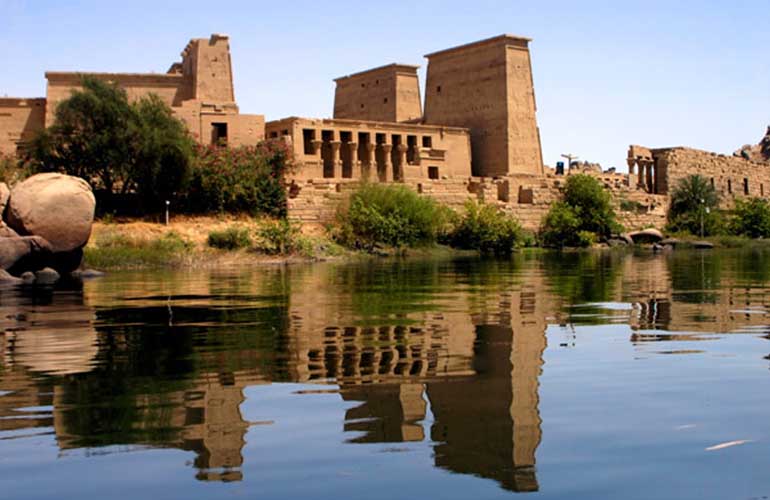Ancient Egyptian Temples Facts:
The Egyptian temples are places of worship of the Gods and the Pharaohs, also the Egyptian temples were the palaces for the deities. In this way, the Egyptian culture throughout its history, built a series of shrines, which according to their mythological beliefs, were sacred places for the gods, while honoring their kings of heavenly lineage.
The Egyptian temples were made of stone, for the simple reason that they were the abode of the immortal gods, so they had to be long-lasting. In this sense, its walls were to protect the deities.
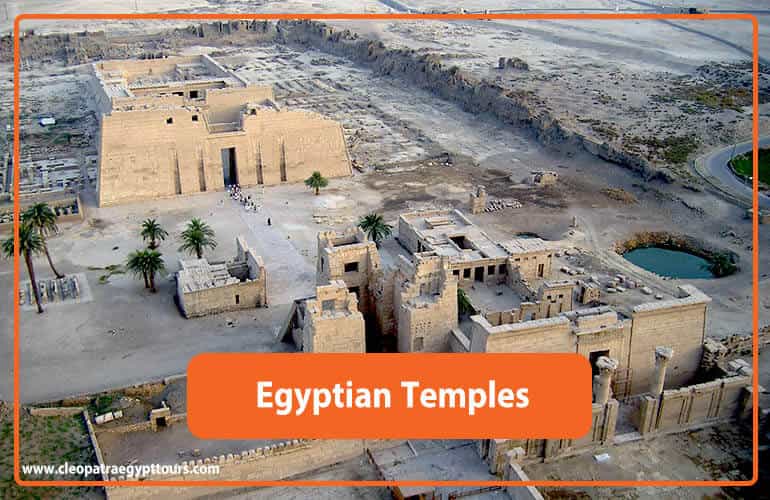
Ancient Egyptian temples features:
Each of the temples built by the Egyptians had a different function, apart from being built for a particular deity, it was also done as a tribute to the pharaoh. the following types of Egyptian temples can be determined:
- Solar Temple
They arise with the intention of deifying the potential of the sun god, Ra. Being located in desert places, the Solar Temple of Niuserre can be distinguished, which is an open-walled courtyard with an altar and behind it a great obelisk where the sun’s rays are reflected. - Funeral
Although they did not have a very marked structure, they were works consecrated to the cult of the Egyptian pharaohs. - Classical
they were dedicated to one God and built-in large fortified enclosures. Among them stand out the Temple of Amun Luxor and the Temple of Karnak
Top 13 Ancient Egyptian temples:
Only the Egyptian pharaohs and priests had access to the temples, although the people could only reach the courtyards during the ceremonies. The rituals that were carried out in them revolved around achieving the protection of the people against the dark energies, and thus to seek the prosperity of ancient Egypt.
1-Karnak temple
Karnak Temple. A complex that not only housed the seat of the great god Amon but also constituted the site of numerous chapels and temples dedicated to other gods.
The Karnak Temple is the largest in Egypt and was throughout history a vast source of knowledge regarding Egyptian culture and deities. Even today, excavations continue to bring to light new discoveries. This is not surprising considering that it was built between 2200 and 360 BC by different pharaohs such as Hatshepsut, Seti I, Ramses II and Ramses III.
The enclosure where the Karnak Temple has located measures 2,400 meters in perimeter and is surrounded by an 8-meter thick adobe wall. The main enclosure for the Temple of Amun retains inside other temples such as those of Khonsu, Ptah, Osiris, the Temple of divine regeneration of Taharqa, Jubilee Temple of Amenhotep II and Ramses III. There are also chapels such as the Tripartite Chapel of the Boat of Seti II.
In Ancient Egypt, the construction of temples always began at the sanctuary, which means that Karnak was started at the center and completed at the entrances to the enclosure. The whole complex was richly decorated and painted in bright colors. The Great Temple of Amon was built along two main axes (east to west and north to south). The core of the temple was located on a mound that must have been sacred, and from this point, the temple expanded and not just towards the Nile, as would have been the case.
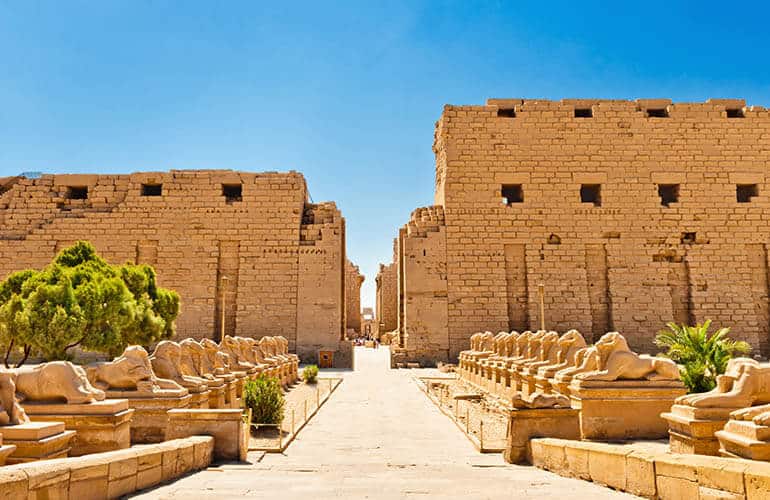
2-Luxor temple
Temple of Luxor. Started by Amenophis III and finished by Ramses II, dedicated to Amon-Ra, Mut.
Two great builders as Amenhotep III and Ramses II were the main responsible for the construction of the temple dedicated to Amun: during the rule of Amenhotep III was built the interior, and the outer enclosure was built under the mandate of Ramses II. But they were not the only ones who left their mark on the great temple. Tutankhamun, Horemheb and even Alexander the Great himself mobilized their workers in pursuit of immortalization.
The temple follows quite faithfully the model of the classical constructions: it consists of a large central courtyard, a hypostyle room, a vestibule, and a sanctuary. The entrance to the temple was decorated with a poem by Pentaur, alluding to the value of the pharaoh in battle. Two obelisks were erected at the front: one of them, 25 meters high, remains there, while the other was moved to Place de la Concorde in Paris in 1836 as a gift from Mohamed Ali.
The entrance is also where the seated statues of Ramses II are located, of unimaginable size, decorated with images of prisoners representing the nine peoples conquered by Egypt. They are made of gray granite and measure more than 15 meters and a half high.
The courtyard is composed of 74 columns in which you can see the pharaoh with different deities. In the center, a sanctuary consists of three chapels, dedicated to Amun, Mut, and Khonsu, decorated by Ramses II. They served as storage for the sacred boats.
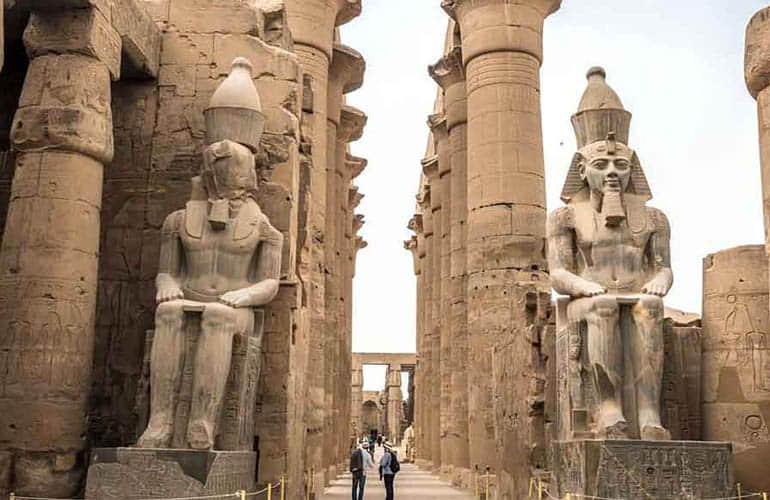
3-Dendera Temple complex
Dendera is a small village located on the west bank of the Nile, 60 km north of Luxor. The temple of Dendera, also known as the House of Hathor, is dedicated to Hathor, the goddess of love, joy, and beauty, who the Greeks assimilate with their Aphrodite.
The Temple was built between 30 BC, making it one of the newest temples in Egypt. However, it was built on top of an older temple, the date of which is still unclear. It is likely that the design of the “new” temple was based on the previous one.
The Hathor temple has a square shape and is surrounded by a portico with columns and thick walls that rise to half the height of the columns. We can find many reliefs of figures and rituals on the outside of the temple.
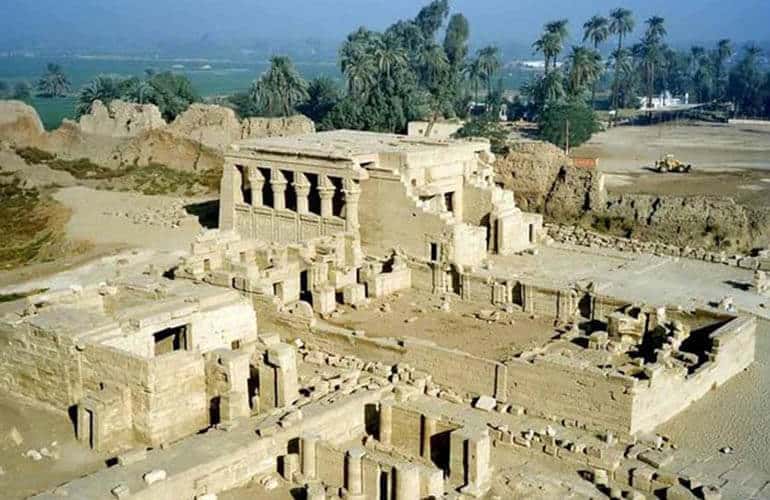
4-Abydos temple
This temple is located in the area of Kom el-Sultan and is practically accompanied by both the temple of Seti I and the temple of Ramses II, as for its age the temple dates in the records from the First Dynasty, which is estimated according to various sites and remains found in the place and identifying that time.
The Temple has not been completely preserved and is worse preserved than the cenotaph Temple of Seti I, but its structure can be completely seen. From the façade, only the lower rows of the second pylon are preserved. As for decoration, there are still many reliefs with their corresponding polychromy, many of them excellently preserved in spite of being outdoors.
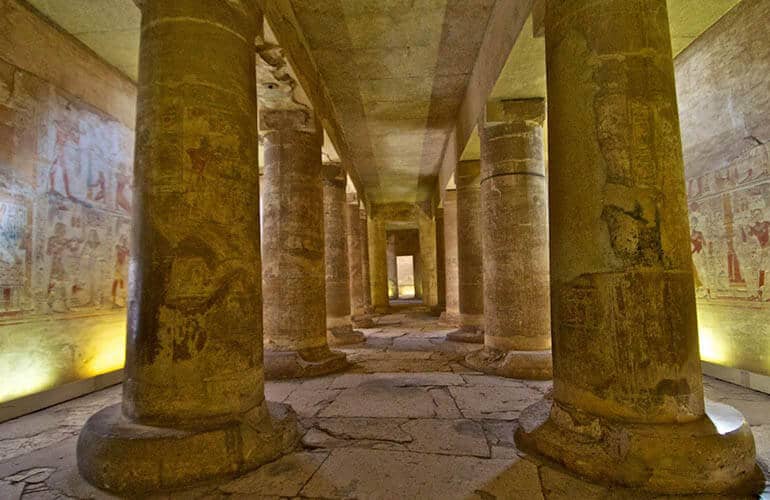
5-Temple of Taffeh
It was built during the Roman period in Egypt, at the whim of Emperor Augustus. Although it was initially an offering in honor of the goddess Isis, in reality, it was part of the military Roman fortress Tapis, in the south of the country. Eventually, it became a temple for Christian worship.
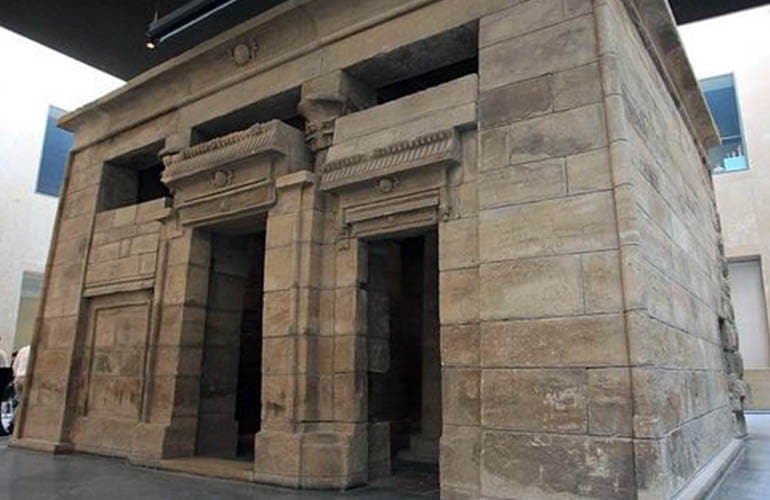
6-Mortuary temple of Hatshepsut
Built by Hatshepsut, the first pharaoh in history, this temple of fine geometric lines is radically different from all the others since it was not built by dragging stones and raising pylons and columns, but was excavated on the Deir el-Bahari escarpment, behind the Valley of the Kings. In some way, it reflects feminine refinement, both in its elegant, almost modern lines and in the beautiful polychrome paintings on its porticos that tell of the Egyptians’ trade expeditions to Somalia.
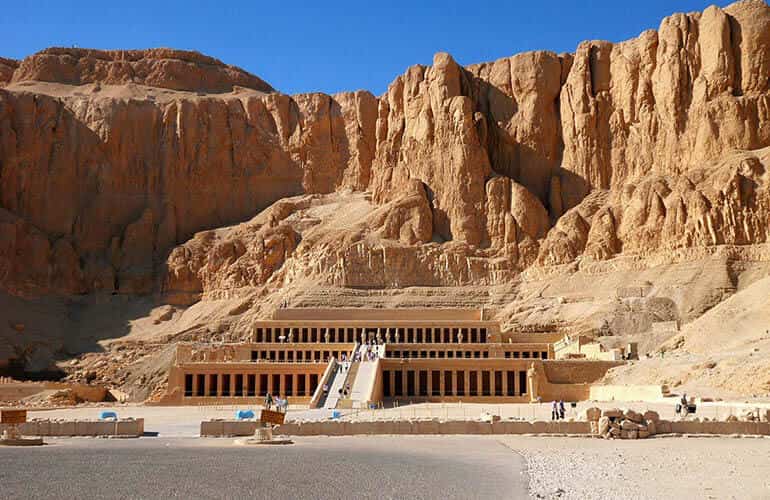
7-The Temple of Horus at Edfu
It is the second-largest temple in Egypt (after Karnak) and probably the best-preserved. It remained almost completely covered by desert sand until the end of 1800, which is why it is in such good condition.
The temple was dedicated to the God Horus, All this central area is covered, and on these ceilings, at one time there were large polychromatic murals. If you go out through any of the sides you will reach an open gallery, in whose walls innumerable hieroglyphics are preserved almost intact, which have been a source of invaluable information for historians. It is, without a doubt, their greatest treasure.
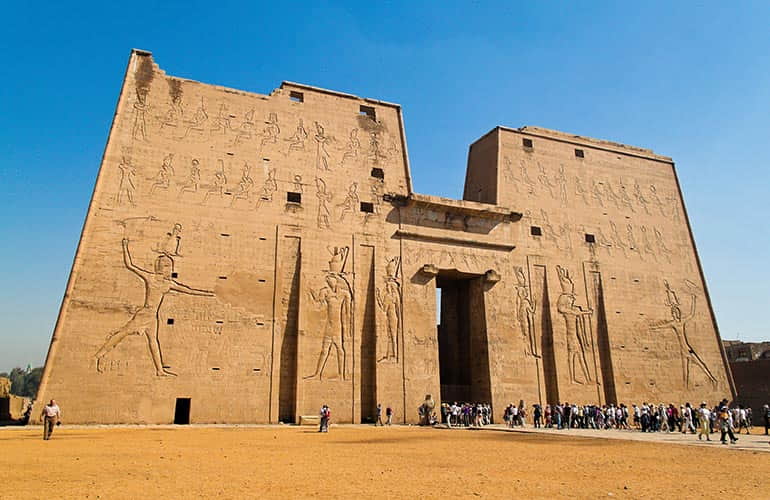
8-Kom Ombo temple
It’s located about 50 km from Aswan. It began to be built under the Ptolemaic dynasty in the second century BC and its main feature, and that makes it unique, is that it is a group divided into two symmetrical temples, each dedicated to a different god. The southern half was dedicated to the god Sobek, represented with a crocodile head, while the northern half was dedicated to the god Horus, with a falcon head. Therefore it was formed by two entrances, two sanctuaries, and two hypostyle rooms, although there are also common areas.
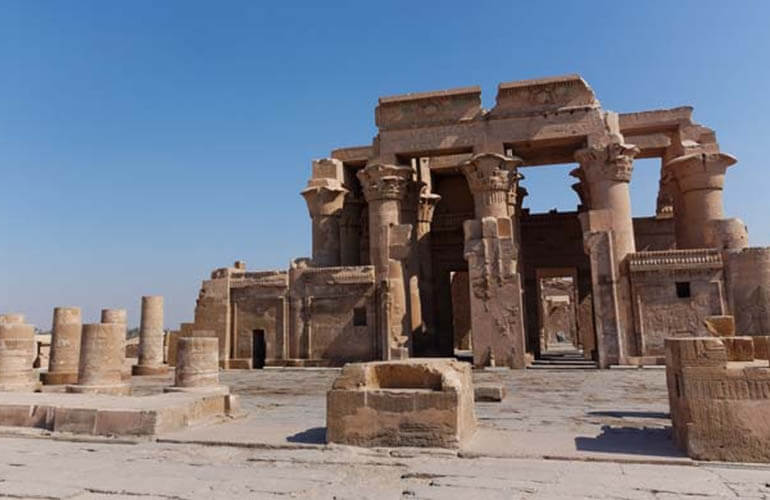
9-Abu Simbel
Abu Simbel is one of the most historically interesting archaeological sites in Ancient Egypt. It was built under the rule of Ramses II (ca. 1274 BC), in homage to the Battle of Kadesh, as well as being dedicated to the worship of Amun, Ra, and Ptah. The purpose of this magnificent construction, which lasted about 20 years, was to impress the people of the south and expand the Egyptian religion in the region.
Accompanying the Great Temple is another smaller – but equally beautiful, which honors the queen Nefertari and the goddess Hathor.
In 1964, the entire site was moved stone by stone some 231 km southwest of Aswan on the western shore of Lake Nasser. Today, it is the Open Air Museum of Nubia and Aswan, a UNESCO World Heritage Site.
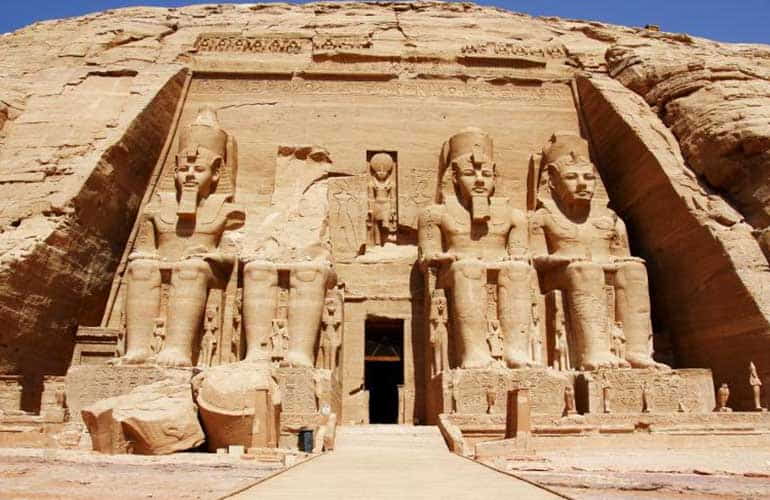
10-Temple of Ellesyia
In the 15th century BC, Pharaoh Thutmose III ordered the construction of a temple to worship the gods Amun, Horus, and Satis. This work, which belonged to the 18th dynasty, was located between the first two waterfalls of the Nile River, being excavated and inserted into the rock itself. On this occasion, the Egyptian government decided to donate it to another country, the cradle of civilization. Thus, in 1965, Italy received with gratitude this monumental gift of incalculable patrimonial value. Today, after being completely restored in 1990, it has become one of the stars of the Egyptian Museum in Turin.
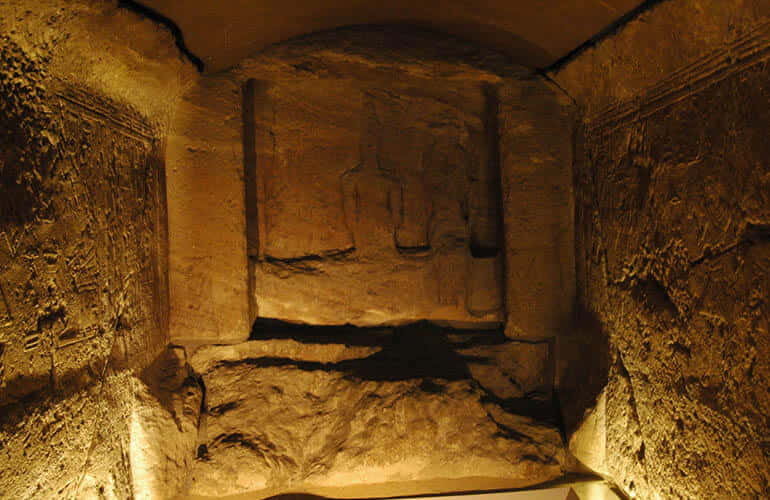
11-Temple of Dendur
The origin of this sanctuary dedicated to the goddess Isis dates back to the Year 15 BC by order of Emperor Augustus, at the time of Gaius Petronius, Prefect of Egypt. Originally erected in Dendur (Nubia), it had to be moved to be preserved. The first stop of its 642 blocks was the island of Elephantine. Since 1967, the magnificent reliefs of Isis, Osiris, Horus, accompanied by lotus flower motifs, can be seen at the MET in New York; thanks to the donation that the Arab Republic of Egypt made in 1965 to the United States Government.
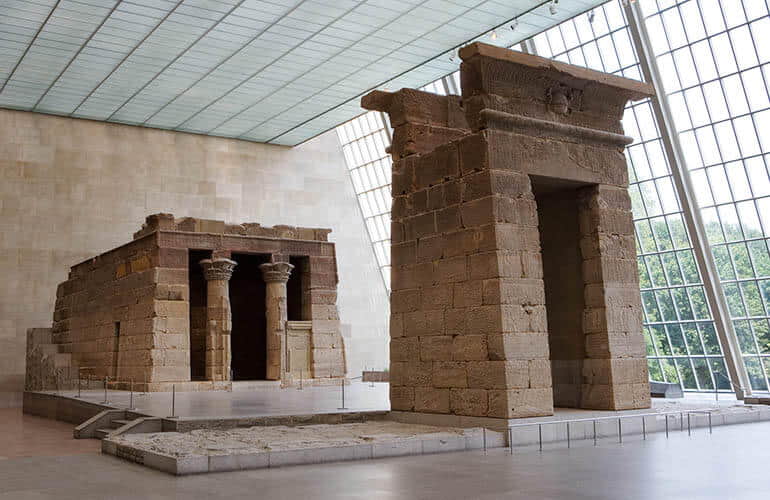
12-Temple of Khnum
Temple of Khnum (Esna)54 km. south of Luxor, the Nile up, very close to the pier of Esna, is found, sunk in a moat of nine meters deep, the temple of Jnum or, better said, a small part of it, the one corresponding to the Roman period, since the rest still remains unexcavated. The roof is supported by 18 columns with various floral capitals, palm leaves, lotus blossoms… and even grape clusters. The most singular are the engravings on the walls, in which you can see Roman emperors making offerings to the local gods dressed as pharaohs.
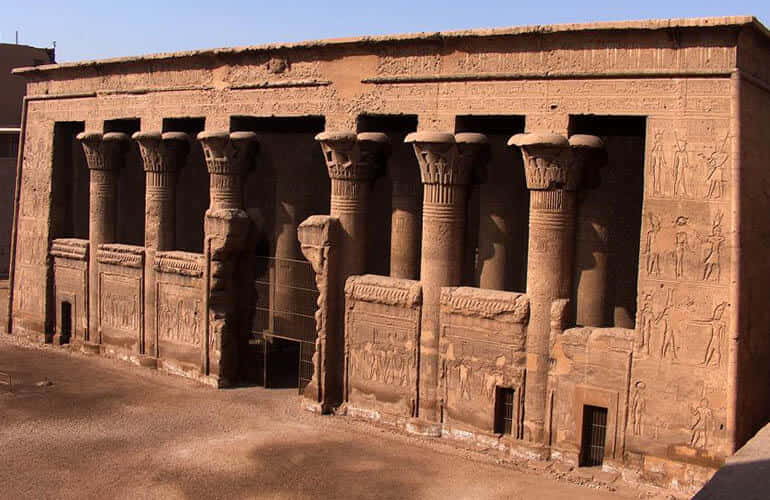
13-Philae Temple
Everything is extraordinary in this delightful temple dedicated to Isis, the Egyptian goddess who came to be venerated throughout the Roman Empire and located on a small island between the first and second Aswan Dam, from the bougainvillea that adorns its surroundings to the wonderful views that can be enjoyed from almost anywhere. The most surprising thing, however, is that this temple was deconstructed, stone by stone, on its original site under the waters of the dam and rebuilt in all its splendor on the small island of Agilkia, twenty meters above.
